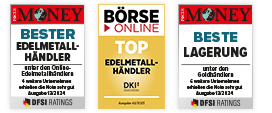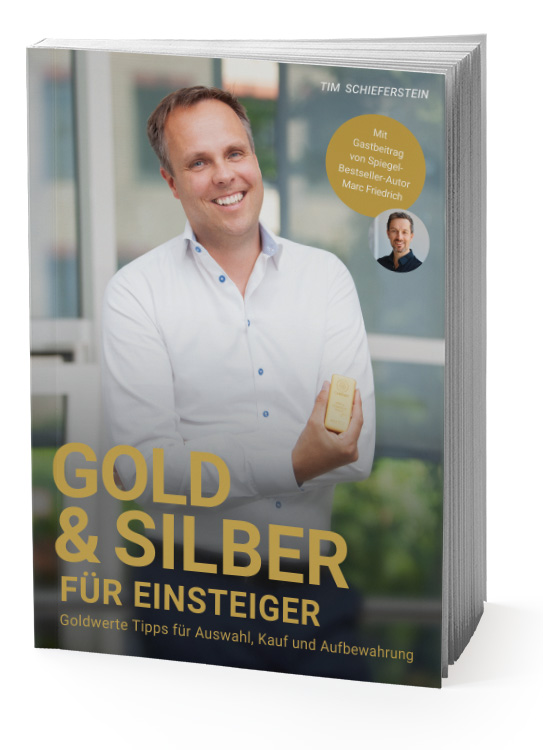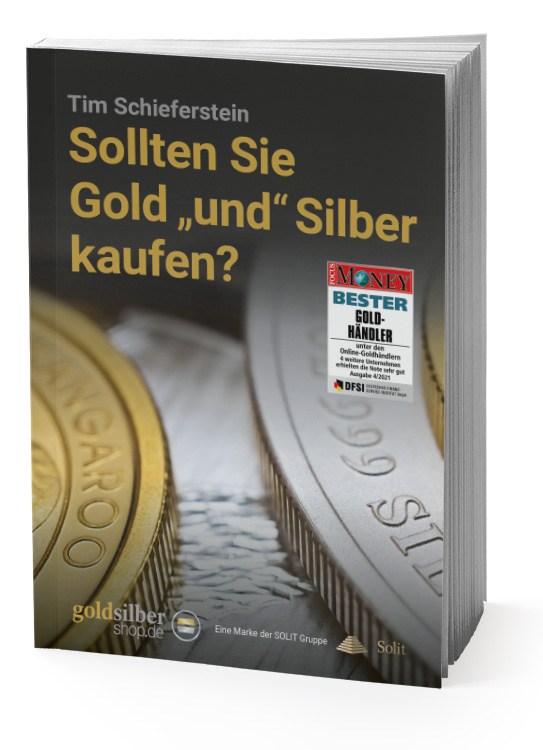Effects of sharply rising precious metal prices
in 2001, silver prices bottomed out at almost 25,000%.
Economic Impact
Adam Smith once opined, "If the quantity of gold and silver imported into a country exceeds the actual demand, no government, however vigilant, can prevent their export."[1] He was alluding to the fact that while the Portuguese and Spanish brought large quantities of precious metals from the Americas to Europe in the 16th and 17th centuries, they exchanged them for spices and silk from China and India, among other places. The thirst for exotic goods from the Far East led to the impoverishment of the Iberian Peninsula, which should have been the richest region in the world. It would certainly not be a mistake to think back on this in the 21st century.
According to the stock market guru André Kostolany, however, investments in gold are dead capital.[2] He justifies this on the grounds that it would deprive the economy of liquidity and make less capital available for investment. However, this is not true. Although the buyer of gold or silver that has already been mined must pay a certain amount for it, the seller receives this amount and can use it to buy consumer or investment goods. The money thus remains in the economic cycle, so investing in precious metals does not withdraw any capital from the economy. On the contrary, buyers of precious metals actually increase the savings rate, which ultimately finances investments (in China, for example, the savings rate is 35%).
Another aspect is economically relevant: Rising precious metal prices change relative prices. Some economists conclude that this distorts the production structure and causes inefficient use of production factors, since too much labor and capital is directed to the mining sector to increase precious metal production and is thus available to a lesser extent in other, supposedly more productive sectors of the economy. The argument would be justified if precious metal prices were to remain permanently at a sub-optimally high level for the economy as a whole - for example, as a result of price manipulation or the formation of a speculative bubble. However, this is likely to be the case only temporarily at best, because fundamentally unjustifiably high prices usually remain at these levels only temporarily. What is usually overlooked is the cause of the price increase, such as the fundamental weakness of the financial and monetary system.
Precious metal prices are formed on markets. How efficient these are in the precious metal sector is a moot point, but they alone decide on the level of precious metal prices (and the markets are always right, as is well known). Here, precious metal supply and demand are brought into balance: on the supply side, depleting economically exploitable deposits will cause rising extraction costs, distortions of the financial system, currency turbulence, debt and inflation will lead to rising investment demand, income increases and the emergence of a strong middle class in the emerging markets will lead to rising jewelry demand and new applications, and the industrialization of the emerging markets will lead to rising industrial demand (especially for silver).
Against the background that precious metal prices are quoted globally and that there are several different supply and demand segments, the interrelationships with regard to aggregate supply, demand and price effects are very complex and can hardly be reproduced with market models. Nevertheless, even strongly rising precious metal prices are in line with efficiency criteria and economic theory. In the longer term, however, rising prices are likely to lead to a weakening of some price-driving factors, while factors acting in the opposite direction, which are discussed below, are gaining in importance.
Substitution Effects for Gold and Silver
Substitution effects can be depicted - at least in principle - with the help of two-good models. According to this model, substitution between two goods is determined by a technically conditioned substitution relationship and by their price ratio. If, for example, the price of silver rises more strongly than the price of a metal that can be considered as a technical alternative, silver consumption for this application can be at least partially substituted. Due to product innovations, application areas that were characterized by high silver consumption have already been displaced on many occasions. The history of silver has sometimes been a story of substitution.[3] The following examples illustrate this:
- Silver was replaced by more corrosion-resistant stainless steel in various applications (e.g., household goods),
- dental amalgam has been displaced by other materials due to its harmful effects on health,
- analog photography, which required large amounts of silver, is increasingly being substituted by digital photography.
However, these processes were mostly less price-induced than technological. Provided that the technological relationship is characterized by low substitution elasticity, even drastic price changes do not trigger substitution. Although rising prices can trigger increased efforts to create these technological conditions, this would require innovation processes that are sometimes of a protracted nature and whose outcome is often uncertain; moreover, they would be associated with research and development costs. As a rule, however, substitution effects in this way, if substitution possibilities are sought at all, are likely to unfold only in the longer term.
It should be borne in mind that (1) precious metals are only required in such small quantities per unit of production in most industrial application areas that the prices are hardly significant, (2) there are no qualitatively sufficient alternatives in many industrial application areas because they cannot be substituted at all due to their unique properties, and (3) if alternatives do exist, the prices of other industrial metals also rise during an upward raw material and precious metal cycle, so that it would not make economic sense to resort to them or to to increase efforts to further develop the potential uses of these alternative metals.
Impact on recycling of gold and silver
Future industrial applications with a high demand for precious metals will have a major impact on prices, especially if the precious metals consumed can only be recycled to a limited extent or not at all. In this context, it is important to bear in mind the aspect already emphasized with regard to substitution effects, namely that precious metals often represent only a marginal cost factor. In addition, a distinction must be made between whether there is a recovery of previously consumed precious metals, which had therefore not led to an increase in stocks - unless, for example, a car containing about one ounce of silver is counted as silver stock - and whether stocks are melted down, for example in the form of jewelry, bars or coins, thereby reducing previously accumulated precious metal stocks. The latter actually only counts as recycling in definitional terms and thus represents an increase in supply, but in fact it is actually a substitution of existing stocks in favor of an industrial or other use.
Thus, via the price mechanism, the market ensures that demand is met by reducing inventories as needed. Such a situation could occur, for example, when we are at the upper turning point of the price cycle. If the majority of market participants then expect prices to fall and are prepared to reduce their inventories, this would dampen demand and price buoyancy. Together with an increase in primary and secondary production by mines, this could herald the transition into a downward price cycle.
A reduction of physical stocks by melting down jewelry, coins or gold or silver goods does not make sense, as a premium to the material value can be achieved for this on the market. Melting down, which may even involve a discount on the material value for the melting down costs, would therefore be irrational. The meltdown of old stocks is therefore - assuming rational behavior - at best a possibility in extreme market situations, for example when regular trading would hardly be possible due to extremely increased and strongly fluctuating prices.
Even and especially in such a situation, however, it should be considered what the paper money that would then be exchanged for precious metals is still worth, since the precious metal prices had not risen without reason before. With physical gold or silver, one is prepared for any conceivable economic crisis, whether inflation, hyperinflation, recession or depression. While a currency reform would largely devalue paper money as well as pensions, life insurance and savings, precious metals would retain a real value and be accepted as a means of payment worldwide.
Exploration as well as production start-up of new mines
In addition to mining above-ground stocks and recovering precious metals that have already been used up (recycling), there is another way to increase the supply of precious metals, namely through increased mining of underground resources. To increase precious metal production, one option is to increase mining in mines already in operation, and another is to build new mines to develop and mine additional deposits. Although it is possible to increase production at existing mines within narrow limits in the short term, production increases then reduce the residual mine life. Even if the resource estimates of a mine are regularly adjusted - usually upward - through new drilling or expansion of the reals, the deposits will be exhausted sooner or later.
The question therefore arises to what extent and under what conditions the construction of new mines comes into question. It should first be noted that the highly mineralized deposits that can be mined at low cost have already been largely discovered and, in part, developed and mined. Due to the availability of modern exploration methods and the fact that, especially in the case of silver, the deposits are predominantly near the surface, surprising new discoveries are rather unlikely or usually only very slightly mineralized. New mines therefore incur significantly higher costs.
In addition, investment costs have risen immensely in recent years. The construction of new mines takes long periods of seven or more years and sometimes involves costs in the billions. These have to be financed in advance over a period of years. The lower the degree of mineralization of the deposit, the higher not only the cash costs but also the fixed costs per ounce, since the costs of building the mine have to be allocated to correspondingly fewer ounces. The profitability calculations of such mining projects are based on assumptions. If these do not materialize as assumed, planned projects fail, which is indeed the case for the majority of projects. It is to be expected that with strongly rising precious metal prices, new mines can become profitable in the future even if comparatively low-mineralized precious metal deposits are found. However, in view of the long period of time that has to be bridged between the first test drillings and the start of production, the sustainability of the assumed development of precious metal prices and the calculated average costs will then be decisive.
Outlook for gold and silver
It is hard for many to imagine that price movements such as those projected here, for example, for the silver price, are at all possible, even though financial market history provides countless examples of similar or even larger-scale changes. Of course, these are not "normal" developments, they rather require extraordinary circumstances. But precisely such circumstances are on the horizon, such as the dramatic shortage of precious metal resources, the massive expansion of precious metal demand, or the glaring dislocations of the world financial and monetary system. Once the broad masses have come to certain insights and investment flows are then steered in this direction, the erratic excesses that can then always be observed in such situations will occur. Sooner or later this will also be the case on the precious metal markets to an extent of which probably very few people have any idea.
It will then also on the precious metal markets temporarily come to irrational exaggerations. Extremely high prices do not necessarily have to be sustainable and long-lasting, because their primary function is to trigger developments that meet dramatically changed supply and demand conditions: On the supply side, the mining of lower-grade deposits and the use of newly developed recovery methods become more economical as a result, and above-ground stocks are reallocated; on the demand side, certain demand components decline or are substituted, and demand capricitates on those with particularly high utility value. Prices will then settle at new levels, subject to strong fluctuations, which will in turn reflect the future developments expected by the majority. However, everyone can participate in the upswing that is initially imminent; corresponding investment opportunities are therefore the subject of"Investment Opportunities Gold and Silver".

Weitere Informationen und Ihre nächsten Schritte:
Geschichte von Edelmetallen als Währung
Angebot, Nachfrage und Bestände
Historische Wertentwicklung
Prognose für die zukünftige Wertentwicklung
Investitionsmöglichkeiten
Zusammenfassung
Silber Neuheiten
Feinsilber
Silber kaufen
1 kg Silbermünzen
1 Unze Silbermünzen
Silberunze
Tubesize
Silberankauf
Ankauf von Silberbarren
Ankauf von Silbermünzen
Maße & Gewicht: Silberbarren
Mehrwertsteuer bei Silber
Silberpreis
Das deutsche Stempelgesetz von 1884
Edelmetalle
Edelmetalle kaufen
Gold, Silber lagern
Gold-Silber-Ratio
Privy Mark Münzen
Goldsparplan
Goldverbot
Buch & eBook “Gold & Silber für Einsteiger” gratis für Sie
„Ein spannendes und lehrreiches Buch, das selbst für Leute wie mich, die sich noch nie mit dieser Thematik auseinandergesetzt haben, das Interesse an einer Investition in Edelmetalle weckt.“ – Fazit der Lektorin, die anschließend erstmalig Gold kaufte.
Was sind die Vor- und Nachteile von Edelmetallen? Welche Barren und Münzen sind warum empfehlenswert? Was sind typische Anfängerfehler und woran erkennt man einen seriösen Edelmetallhändler? Wo und wie bewahrt man Edelmetalle sicher auf? Auf diese und viele weitere Fragen finden (nicht nur) Einsteiger in dieser rund 200 Seiten umfassende Basislektüre von Edelmetall-Experte Tim Schieferstein zum Thema Gold und Silber Antworten und Tipps.
Mit diesem Buch möchten wir Aufklärungsarbeit leisten und so den Einstieg in eine Kapitalanlage in Edelmetallen leicht machen. Daher schenkt GoldSilberShop.de sowohl das eBook als auch das gedruckte Buch Ihnen! Sichern Sie sich noch heute Ihr Exemplar!
Ratgeber zum Gold- und Silberkauf gratis als eBook
In diesem Ratgeber geht es weniger darum, welche Fehler Sie beim Kauf von Gold und Silber vermeiden sollten, sondern welche Unterschiede und Gemeinsamkeiten bzw. Vor- und Nachteile die beiden Edelmetalle Gold und Silber im Vergleich haben? Worauf muss man beim Gold- bzw. Silberkauf achten? Wie verhält sich das Gold-Silber-Ratio und wo können Sie dieses und viele weitere brandaktuelle Informationen einsehen? Sie erhalten unseren Ratgeber kostenlos als PDF-Datei, wenn Sie sich für unseren Newsletter anmelden.







